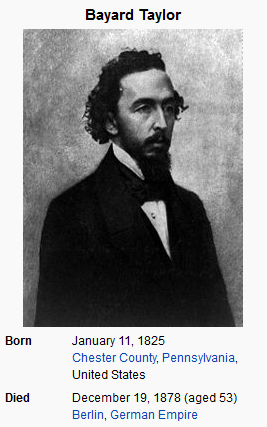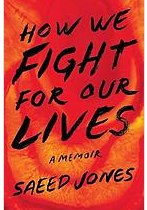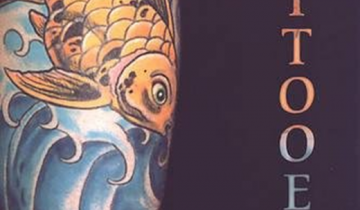Off the Shelf #3: The World of Joseph and His Friend: Nineteenth Century American Writing and Same-Sex Love
By Rob Ridinger
 In 1870, the prolific American journalist, poet, essayist and travel writer Bayard Taylor filed a new work with the Library of Congress, a novel entitled Joseph and His Friend, which carried the subtitle “A Story of Pennsylvania.” Taylor prefaced the work with a one-page statement of the various audiences who will find the tale enjoyable:
In 1870, the prolific American journalist, poet, essayist and travel writer Bayard Taylor filed a new work with the Library of Congress, a novel entitled Joseph and His Friend, which carried the subtitle “A Story of Pennsylvania.” Taylor prefaced the work with a one-page statement of the various audiences who will find the tale enjoyable:
To those who prefer quiet pictures of life to startling incidents, the attempt to illustrate the development of character to the mysteries of an elaborate plot, and the presentation of men and women in their mixed strength and weakness to the painting of wholly virtuous ideals and wholly evil examples: who are as interested in seeing moral and intellectual forces at work in a simple country community as on a more conspicuous plane of human action : who believe in the truth and tenderness of man’s love for man, as of man’s love for woman: who recognize the trouble which confused ideas of life and the lack of high and intelligent culture bring upon a great portion of our country population- to all such, no explanation of this volume is necessary. Others will not read it. (Taylor 1870: n.p.)
The phrase “the truth and tenderness of man’s love for man, as of man’s love for woman” has been noted by literary historians attempting to track the appearance and evolution of the portrayal of LGBT people in fiction, although the work has perhaps not received the attention it warrants. To help evaluate the question of whether this is in fact among the first works of American fiction in English to show a same-sex love affair between two men, it is useful to look at both the author and the approach to homosexuality current at the time Putnam and Sons issued the first edition. Prior to its being issued by Putnam, Joseph and His Friend initially appeared as a serial in the Atlantic Monthly beginning in January 1870 (the only one of Taylor’s novels to be so treated), with the closing four chapters completing the work published in the December 1870 issue.
Like the title character of Joseph and his Friend, Bayard Taylor was a Pennsylvanian, born at Kennett Square in Chester County on January 11, 1825 to a Quaker farmer and his wife. By the age of seventeen, he had shown a deep interest in composing poetry and was encouraged by the Philadelphia critic Rufus Griswold to put together a collection of his work. When it appeared in 1844, Ximena, or the Battle of the Sierra Morena, and other Poems marked the beginning of a writing career that would span more than half a century. The book sold well enough to fund Taylor on a two-year trip to Europe, whose adventures and insights were shared with the American newspaper reading public with the publication of his account of his travels Views A-Foot in 1846. This was the first of an eventual eleven books of travel accounts Taylor would regale the American public with, taking his audiences to places as unfamiliar as Japan ( as a member of the expedition headed by Commodore Perry ), South Africa, Egypt and the Nile Valley, and Yellowstone National Park. By the beginning of the Civil War, he had joined the staff of the New York Herald Tribune under the leadership of Horace Greeley.
The question of why Taylor’s name is not more recognizable to later generations of readers lies in the way attitudes towards the literature of travel and the value assigned to it have changed since his time. During the nineteenth century, travelers’ accounts were a more respected and recognized genre of literature than they would become during the twentieth century, due in part to contributions to the body of work by major writers such as Mark Twain, but also for the world in which their audience lived. Many, if not all, of the American reading public in the nineteenth century traveled very little outside their home towns or regions, and so direct experience of distant places with exotic names and cultures was severely limited if not totally absent. The author of a travel account could inform his readers of everything from daily life in California during the frantic days of the Gold Rush to what a sunrise looked like over the valley of the Nile, or carry them into the streets of London, and his words would be avidly devoured, particularly if the places described had dangerous, romantic or exotic reputations. As the antebellum era gave way to the upheavals of the Civil War in the United States and the proliferation of the British Empire with its diverse colonial possessions, there was an explosion of personal accounts of journeys to and service in distant lands, including the narratives of scientific expeditions. This increased number of works (some of doubtful literary quality) somewhat diluted the impact such works had had in earlier decades.
A more complex issue is how Joseph and His Friend fits into the approach taken to male-male friendships and love in American literature of the middle and late nineteenth century. In 1856, an anonymous essay entitled “The Literature of Friendship “appeared in the North American Review written by a clergyman cousin of the famed pulp author Horatio Alger. Rev. William Alger’s text presented both examples of famous male friendships across the centuries from classical Greek and Roman civilizations to then-contemporary times, and a valuable exploration of major writers and thinkers who had pondered the nature of friendship in both ideal and lived-out forms. The impressive list ranges from Aristotle, Cicero and Plato to names more familiar to the audience of the 1850s such as Thoreau, Tennyson , Shelley and Emerson. Alger lamented that there seemed to have been a decline in the value placed upon such friendships between men in American life and called for a restoration of the recognition that such bonds were both lasting and valuable.
The principal value of Alger’s essay lies in its provision of context for a literary phenomenon that began about the time of the beginning of the Civil War and would continue for the next three decades, the production of a body of short stories and novels dedicated to exploring the ideals of “brotherly love.” The degree to which this concept was considered socially acceptable can be seen by looking at the authors who produced it, all of whom were well-known and respected literary figures. The list of names includes, in addition to Bayard Taylor, the familiar names of Henry James, Bret Harte, and even Mark Twain.
The basic plot of Taylor’s novel (which was reprinted no fewer than eight times between 1872 and 1893) follows the lives of Pennsylvania farmer Joseph Asten and Philip Held, the “friend” of the title, and the evolution of their bonds of friendship and affection, interwoven with philosophical speculations on love and its meanings as well as the flaws in human character and the limits of happiness in marriage. Joseph was first translated into German in 1879, one year after Taylor’s death on December 19, 1878, with a subsequent edition appearing in Belin in 1900 as Joseph und sein Freund and an English edition issued in London by the Knickerbocker Press in 1903. The date of the initial German translation is interesting, as it means that this novel would have been potentially read by the same audience who were following the homosexual rights advocacy of lawyer Karl Heinrich Ulrichs through his writings under the pseudonym of Numa Numantius. The text of Joseph was reproduced in 1972 by University Microfilms as part of their American Culture Series, and has also been included in the Hathi Trust database.
While the term “homosexual” first appears in a pamphlet written published in German by Karl-Maria Benkert in 1869, the word was not introduced to English until 1892, when a translation of Krafft-Ebing’s compendium Psychopathia Sexuaiis was published. Thus, twentieth-century readers who became aware of the body of novels created during the era of romantic friendship would have brought a very different set of criteria to the interpretation and dissemination of these works. Librarians faced with patrons interested in tracking the history and treatment of same-sex love in fiction prior to the somewhat more familiar writers of the Victorian era thus face a dual challenge of identifying works from mainstream writers which portray romantic friendships between men, and familiarizing themselves with the available titles in literary history that give an overview of the topic.
Scholarship on this genre has expanded in the last ten years beyond Roger Austen’s original 1977 study Playing The Game: The Homosexual Novel in America. In 2003, The Romantic Friendship Reader: Love Stories Between Men in Victorian America edited by Axel Nissen appeared, which includes an excerpt from Bayard Taylor’s 1854 account A Journey to Central Africa describing his relationship with an older companion on a 4,000-mile voyage up the Nile that reached beyond Khartoum (the choice of this excerpt is interesting, as the African account was paired with the text of Joseph and His Friend in an 1883 edition). Six years later, Nissen produced a more comprehensive and focused study, Manly Love, which provides a readable account of friendship literature and places it in cultural context. Biographical works written on Taylor in the twentieth century are more limited in number, the three most recent being Richmond Beatty’s Bayard Taylor : Laureate of the Gilded Age (1936), Richard Cary’s The Genteel Circle : Bayard Taylor and His New York Friends (1952), and Paul Wermuth’s 1973 work issued as part of Twayne’s United States Authors Series.
For librarians wishing to explore the same-sex literature of the Gilded Age, perhaps the most valuable guide to assessing works in their collections can be found in the introduction to the Romantic Friendship Reader, where Axel Nissen offers a workable definition of romantic friendships between men. He notes that they are “noninstitutionalized, socially sanctioned, (often) temporarily limited and premarital, (ostensibly platonic), nonexclusive yet primary emotional relationships, usually between coeval, coequal , young white men of the middle and upper classes.” (Nissen, 2009 : 4). Bayard Taylor would have approved.
Bibliography
Austen, Roger. Playing The Game: The Homosexual Novel in America. Indianapolis/New York: Bobbs-Merrill Company, 1977.
Beatty , Richmond Croom. Bayard Taylor : Laureate of the Gilded Age. Norman : University of Oklahoma Press, 1936.
Cary, Richard. The Genteel Circle : Bayard Taylor and His New York Friends . Ithaca : Cornell University Press, 1952.
Nissen, Axel. Manly Love: Romantic Friendship in American Fiction. Chicago, Illinois: University of Chicago Press, 2009.
Nissen, Axel. The Romantic Friendship Reader: Love Stories Between Men in Victorian America. Boston: Northeastern University Press, 2003.
Taylor, Bayard. Joseph and His Friend : A Story of Pennsylvania. New York: G.P.Putnam and Sons, 1870.
Wermuth, Paul C. Bayard Taylor. New York: Twayne Publishers, 1973.
Copyright R. Ridinger 2015.




… [Trackback]
[…] Read More: glbtrt.ala.org/reviews/off-the-shelf-3-the-world-of-joseph-and-his-friend/ […]